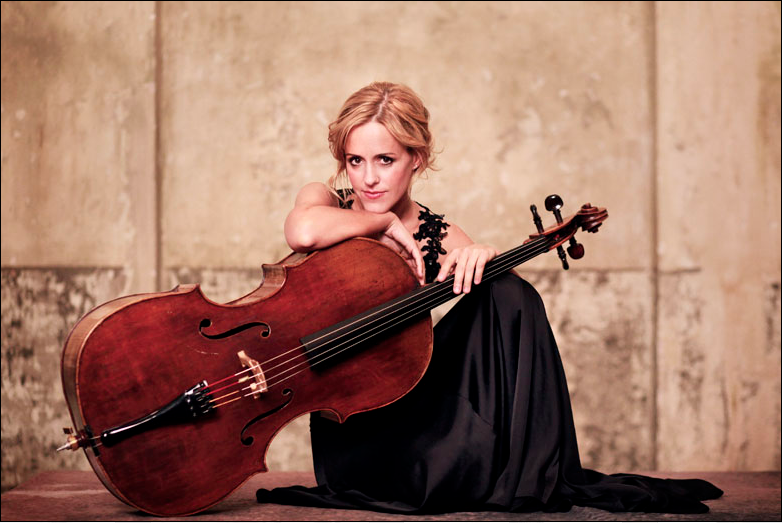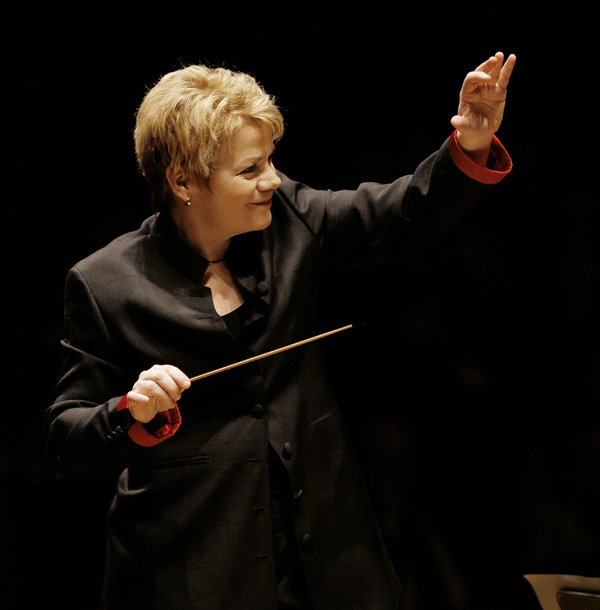Sol Gabetta, Marin Alsop / London Philharmonic Orchestra
Elgar / Mahler
KKL, Lucerne Festival, 2018-09-14

2018-10-08 — Original posting
Künstlerische Reife und Kindheits-Rückblick: Sol Gabettas Elgar und Marin Alsops Mahler — Zusammenfassung
Sol Gabetta überzeugte mit einer reifen, subtil-expressiven Interpretation von Elgars Cellokonzert. Zugabe: Sospiri, op.70 vom gleichen Komponisten. Sorgfältig, stimmungs- und ausdrucksvoll nach der Pause Mahlers Erste mit Marin Alsop und den Londoner Philharmonikern.
Table of Contents
Introduction
The last concert that I attended at this year’s Lucerne Festival was an orchestral event with the London Philharmonic Orchestra under the direction of the American conductor Marin Alsop. This was my first encounter with orchestra and conductor.
The London Philharmonic Orchestra
The London Philharmonic Orchestra is one of five major, professional orchestras in London. It goes back to 1932. Its founders were Sir Thomas Beecham (1879 – 1961) and Malcolm Sargent (1895 – 1967). In this year’s Lucerne Festival, it was one of several American and English Orchestras that dominated the last week at the KKL (Lucerne Culture and Congress Centre).
The Conductor: Marin Alsop
Marin Alsop (*1956, see also Wikipedia) grew up in New York. She started off in music with a Master’s degree as a violinist from Juilliard School. She received support and mentoring from Leonard Bernstein (1918 – 1990), which launched her career as a conductor. In the course of her career, she worked as principal conductor and music director with various orchestras in the States. In 2007, Marin Alsop became music director of the Baltimore Symphony Orchestra, a position that she still holds today. Marin Alsop also worked as principal conductor and principal guest conductor with various orchestras in the U.K., as well as in São Paolo. Since 2014, she has also started working with orchestras in Continental Europe. In 2019, she is to become chief conductor of the Vienna Radio Symphony Orchestra.
The Soloist: Sol Gabetta
Sol Gabetta (*1981) was born in Argentina, but is now living in Switzerland. This was my third encounter with this soloist: I first heard her in a duo recital in Lucerne, on 2017-01-17 (Beethoven, Prokofiev). Then again three months later, on 2017-04-25, in an orchestral concert in Zurich’s Tonhalle, where she was playing the second cello concerto by Dmitri Shostakovich (1906 – 1975).
The Program
The general theme for this year’s Lucerne Festival was “Childhood”. In following that theme, Marin Alsop selected an excerpt from Elgar’s Suites “The Wand of Youth” for starting. And she ended the concert with Mahler’s first symphony, which “digests” memories from the composer’s youth. At the center of the program, though, the “Artiste étoile” of this year’s festival, Sol Gabetta was the soloist in Elgar’s cello concerto.
- Elgar: “The Wand of Youth”, Suites No.1 & 2 for Orchestra (Excerpts)
- Elgar: Cello Concerto in E minor, op.85
- Encore — Elgar: Sospiri, op.70
(Intermission)
- Encore — Elgar: Sospiri, op.70
- Mahler: Symphony No.1 in D major, “Titan”
Setting, Venue, Appearance
The was quite a contrast to the American orchestra in the concert two days earlier, the appearance of the London Philharmonic Orchestra was perfectly organized, staged even. The orchestra played in post-romantic arrangement (both violins at the left, cellos on the right side of the podium). I also felt that the uniform dress code (black, trousers for everybody, tails for men) minimized the distraction, calmed the visual impression, yet was certainly appropriately festive.
The White Hall of the KKL was sold out. My seat was on the left side of row 3 of the first balcony (seat #24), with excellent view (better than in the parquet seating) and excellent acoustics.
Elgar: “The Wand of Youth”, Suites No.1 & 2 for Orchestra (Excerpts)
1907 / 1908, Sir Edward William Elgar (1857 – 1934) picked up again some tunes that he had composed as a boy. He presented two suites, both named “The Wand of Youth”, Music to a Child’s Play. As start of the concert program, Marin Alsop selected the first piece from the first suite, followed by the last two pieces in the second suite:
- “The Wand of Youth”, Music to a Child’s Play, Suite No.1 for Orchestra, op.1a
- Overture: Allegro molto
- Serenade: Andantino
- Minuet (Old Style): Andante
- Sun Dance: Presto
- Fairy Pipers: Allegretto
- Slumber Scene: Moderato
- Fairies and Giants: Presto
- “The Wand of Youth”, Music to a Child’s Play, Suite No.2 for Orchestra, op.1b
- March: Alla Marcia (Allegro moderato)
- The Little Bells (Scherzino): Allegro molto
- Moths and Butterflies (Dance): Allegretto
- Fountain Dance: Allegretto comodo
- The Tame Bear: Allegro moderato
- The Wild Bears: Presto
Taken together, the three selected movements formed a three-part overture, fast–slow(er)–fast, as if it were to imitate an early classical overture.
The Performance
The Overture: an f beat as opening, very effective in instantly attracting the audience’s attention to the music. It’s a short piece, full of drive and momentum: not very demanding, lacking development. The latter is understandable, given its duration of less than 2 minutes.
The Tame Bear is very tame, indeed (and a small bear, too): a little longer (still below 3 minutes, though), a pleasant intermezzo, carefully tuned in its dynamics and phrasing. The woodwinds dominate this movement.
The Wild Bears on the other hand is a vivid dance, full of fun, virtuosic and agile: a little orchestral showpiece, if it wasn’t so short. Altogether, the three pieces that Marin Alsop selected didn’t just offer an excellent, first presentation of the orchestra, but they were also excellent in preparing the audience, the atmosphere for the concerto that followed.
Marin Alsop, although unpretentious in her appearance, knew exactly how to work with and control the orchestra. In her stature, she is almost inconspicuous. And she did not try compensating this with spectacular actions. Her conducting gestures were clear, precise, she stood there, firmly anchored on the podium, the pivotal role in the entire performance. Only occasionally, she used far-reaching gestures to highlight key phrases.
The clarity of the soundscape, the controlled, finely tuned dynamics, and the consequence in phrasing and articulation gave a clear testimony of her serious and thorough preparation with the orchestra. I would characterize her and the orchestra’s performance the result of solid preparation and rehearsing. It was certainly more than that of spontaneous (let alone improvised) reaction to momentary mood and atmosphere.
Rating: ★★★½
Elgar: Cello Concerto in E minor, op.85
Sir Edward William Elgar (1857 – 1934) wrote his Cello Concerto in E minor, op.85 in summer 1919, in the aftermath of the First World War. It was his last major work. The composition had a bad premiere (due to lack of rehearsal time, apparently). It was only in the 1960s that the concerto gained widespread popularity, when Jacqueline du Pré, OBE (1945 – 1987) “threw her life into this concerto” and recorded it. It has since become a core piece of the cello repertoire. The four movements of the concerto are
- Adagio – Moderato —
- Lento – Allegro molto
- Adagio
- Allegro – Moderato – Allegro, ma non troppo – Poco più lento – Adagio
I have written about a performance of this concerto in a review from a concert in London, earlier this year. See there for more comments on the composition.
The Performance
I. Adagio – Moderato —
In Sol Gabetta’s performance, the opening motif wasn’t an emotional explosion, but rather an intense, but noble, considerate gesture, carefully articulated. Gradually, it turned more retained, then almost disappearing into the finest ppp, lost in thought, hesitant in the ascending, seamless transition to the orchestral theme in the violas. Despite the intermediate emotional, epic upswing, so typical of Elgar, the dominating part of the open movement was in calm, melancholic cantilenas with subtle agogics, intense, elegiac, thoroughly emotional, but never excessively expressive, let alone extroverted.
II. Lento – Allegro molto
The quavering theme started off almost like whispered stuttering, gaining intensity only gradually. Also in the soft, p segments, the cellist retained a central presence, despite light articulation: she never seemed to play herself into the foreground. In all this, she closely cooperated with conductor and orchestra through visual contacts. The orchestral accompaniment was very careful and diligent at all times. A brilliant piece, alternating between joyful and moody, with melancholic moments.
III. Adagio
Restrained warmth in the slow movement: gentle, calm singing, extremely touching in the softest, most subtle moments. Sol Gabetta never exaggerated the romanticism, yet was utterly intense, completely capturing the audience, playing into their hearts. In many ways, the music seemed so close to the middle movement in the Cello Concerto on A minor, op.129 by Robert Schumann (1810 – 1856)!
IV. Allegro – Moderato – Allegro, ma non troppo – Poco più lento – Adagio
The solo part in the last movement started with a guided, controlled recitativo accompagnato, though with emotional rubato. Only in the cadenza, this mutated into a completely free recitative. Thereafter, drive and momentum dominated, both in the orchestra, as well as in the solo (e.g., in the arpeggiando of the animato segment). The return to Tempo I ([59] in the score) brought emphasis in perfect union with the orchestra, through all of Elgar’s frequent tempo alterations, allargandi, accelerandi, etc.
Sol Gabetta consciously varied her vibrato, kept it controlled and harmonious. She was very subtle in her dynamics, especially prior to the return of the very first theme / motif ([72], Adagio, come prima), close to the ending.
A masterful performance throughout, clearly showing Sol Gabetta’s “handwriting”!
Rating: ★★★★½
Encore — Elgar: Sospiri, op.70
Certainly not (or not only) because people might consider Sol Gabetta a “local artist / hero”, the applause—deservedly—was very strong. So, the soloist offered an encore, again by Sir Edward Elgar. The piece Sospiri, op.70 was initially intended for violin and piano (as a companion piece to Salut d’Amour, op.12), though the final version is an Adagio for string orchestra, harp (or piano), and organ (or harmonium). Elgar completed this in 1914, just before the outbreak of the First World War. The original title was “Soupir d’Amour” (Sighs of love). Sol Gabetta played an arrangement for string orchestra, harp and cello.
Interestingly, the originally intended companion piece, Salut d’Amour, op.12 was the final encore in an orchestral concert at the Lucerne Festival, the week before. I found that to be fairly shallow, in the way it was presented (and not a good ending to the concert). Here, however, certainly in Sol Gabetta’s hands, Sospiri was not only very touching and atmospheric, but also at the same time an excellent fit to the concerto. And it was the perfect transition into the intermission. Well done!
Mahler: Symphony No.1 in D major, “Titan”
Gustav Mahler (1860 – 1911) composed his Symphony No.1 in D major, “Titan” in 1887 / 1888. The symphony has four movements as follows:
- Langsam, schleppend, Wie ein Naturlaut — Sehr gemächlich
(Slowly, dragging. Like a sound from nature — Very restrained) - Kräftig bewegt, doch nicht zu schnell — Trio: Recht gemächlich
(Moving strongly, but not too quickly — Trio: Rather restrained) - Feierlich und gemessen, ohne zu schleppen — Sehr einfach und schlicht wie eine Volksweise — Wieder etwas bewegter, wie im Anfang
(Solemnly and measured, without dragging — Very simple, like a folk-tune — Once again somewhat more agitated, as at the start) - Stürmisch bewegt – Energisch
(Stormily agitated – Energetic)
Also here, I have heard the symphony in a concert, this time in Zurich, two years ago—see there for additional information on the composition.
The Performance
I. Langsam, schleppend, Wie ein Naturlaut — Sehr gemächlich
The movement evolves from the softest of sounds. It felt like the awakening of nature from the silence of the night. Marin Alsop and the orchestra carefully followed the subtleties in Mahler’s dynamic annotation in the score: barely audible the ppp that accompanies the pp in the winds. Also the joyful bird songs that gradually set in, the distant trumpet and horn calls, and the emerging children and folk tunes, they all remained restrained, carefully controlled for a long time—all serenity and calm. Marin Alsop carefully shaped the dynamics and the tempo. One noted that same care in the orchestra, in the smooth sound of the horns, the diligent articulation in the winds, even the deliberately conspicuous glissandi in the cellos.
II. Kräftig bewegt, doch nicht zu schnell — Trio: Recht gemächlich
Also the second movement was very atmospheric, full of inner harmony. There were no signs of unrest, nor exuberant excesses as found occasionally with other conductors. The excellent acoustics in the KKL’s White Hall offered the ideal support for the transparency of the orchestral soundscape. It never made the sound feel “thick”, rather kept it lucid, spatially clear and well-resolved. Given the diligence that Marin Alsop applied, it was no surprise to note that she observed all of Mahler’s repeats.
III. Feierlich und gemessen, ohne zu schleppen — Sehr einfach und schlicht wie eine Volksweise
Mahler wants the children’s song in the double bass to be played with mutes. Here, it appeared deliberately inartistic, simple, retained, very soft, without any vibrato. This persisted throughout the canon, up to the entry of the trumpets. At [6], with the appearance of the cymbals, Mahler denotes “Mit Parodie“, i.e., with parody. This was maybe a little too controlled. Only towards the end of the movement, the music momentarily felt like a caricature.
IV. Stürmisch bewegt – Energisch
The sudden, loud and coarse beginning is Mahler’s intent: almost chaotic, only gradually getting organized. The composer wanted this to sound wild. All the more, the intense singing of the violins at the “Sehr gesangvoll” (very cantabile) at [16] stood out in its melodic beauty: very expressive, but never too sweet. Never, the performance was aiming for pure effect. My only quibble could have been my personal impression: towards the end, Marin Alsop’s careful, controlled approach was in danger of losing tension. It seemed to take a deliberate effort to re-gain the momentum towards the end. However, this had no impact on the overall impression of a consistent, compelling interpretation.
Rating: ★★★★
Addendum
For this concert I have also written a (shorter) review in German for Bachtrack.com. This posting is not a translation of the Bachtrack review, the rights of which remain with Bachtrack.com. I created the German review using a subset of the notes taken during this concert. I wanted to enable my non-German speaking readers to read about my concert experience as well. Therefore, I have taken my original notes as a loose basis for this separate posting. I’m including additional material that is not present in the Bachtrack review.



